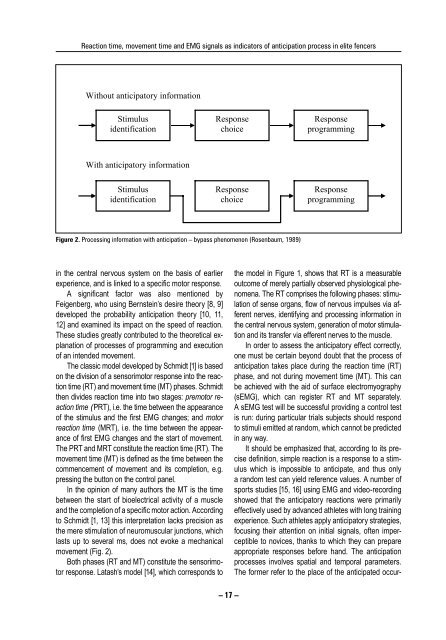Antropomotoryka nr 51 - Akademia Wychowania Fizycznego w ...
Antropomotoryka nr 51 - Akademia Wychowania Fizycznego w ...
Antropomotoryka nr 51 - Akademia Wychowania Fizycznego w ...
- No tags were found...
You also want an ePaper? Increase the reach of your titles
YUMPU automatically turns print PDFs into web optimized ePapers that Google loves.
Reaction time, movement time and EMG signals as indicators of anticipation process in elite fencersWithout anticipatory informationStimulusidentificationResponsechoiceResponseprogrammingWith anticipatory informationStimulusidentificationResponsechoiceResponseprogrammingFigure 2. Processing information with anticipation – bypass phenomenon (Rosenbaum, 1989)in the central nervous system on the basis of earlierexperience, and is linked to a specific motor response.A significant factor was also mentioned byFeigenberg, who using Bernstein’s desire theory [8, 9]developed the probability anticipation theory [10, 11,12] and examined its impact on the speed of reaction.These studies greatly contributed to the theoretical explanationof processes of programming and executionof an intended movement.The classic model developed by Schmidt [1] is basedon the division of a sensorimotor response into the reactiontime (RT) and movement time (MT) phases. Schmidtthen divides reaction time into two stages: premotor reactiontime (PRT), i.e. the time between the appearanceof the stimulus and the first EMG changes; and motorreaction time (MRT), i.e. the time between the appearanceof first EMG changes and the start of movement.The PRT and MRT constitute the reaction time (RT). Themovement time (MT) is defined as the time between thecommencement of movement and its completion, e.g.pressing the button on the control panel.In the opinion of many authors the MT is the timebetween the start of bioelectrical activity of a muscleand the completion of a specific motor action. Accordingto Schmidt [1, 13] this interpretation lacks precision asthe mere stimulation of neuromuscular junctions, whichlasts up to several ms, does not evoke a mechanicalmovement (Fig. 2).Both phases (RT and MT) constitute the sensorimotorresponse. Latash’s model [14], which corresponds tothe model in Figure 1, shows that RT is a measurableoutcome of merely partially observed physiological phenomena.The RT comprises the following phases: stimulationof sense organs, flow of nervous impulses via afferentnerves, identifying and processing information inthe central nervous system, generation of motor stimulationand its transfer via efferent nerves to the muscle.In order to assess the anticipatory effect correctly,one must be certain beyond doubt that the process ofanticipation takes place during the reaction time (RT)phase, and not during movement time (MT). This canbe achieved with the aid of surface electromyography(sEMG), which can register RT and MT separately.A sEMG test will be successful providing a control testis run: during particular trials subjects should respondto stimuli emitted at random, which cannot be predictedin any way.It should be emphasized that, according to its precisedefinition, simple reaction is a response to a stimuluswhich is impossible to anticipate, and thus onlya random test can yield reference values. A number ofsports studies [15, 16] using EMG and video-recordingshowed that the anticipatory reactions were primarilyeffectively used by advanced athletes with long trainingexperience. Such athletes apply anticipatory strategies,focusing their attention on initial signals, often imperceptibleto novices, thanks to which they can prepareappropriate responses before hand. The anticipationprocesses involves spatial and temporal parameters.The former refer to the place of the anticipated occur-– 17 –





![Antropomotoryka nr 57 [2012]. - Akademia Wychowania Fizycznego ...](https://img.yumpu.com/50213388/1/182x260/antropomotoryka-nr-57-2012-akademia-wychowania-fizycznego-.jpg?quality=85)










